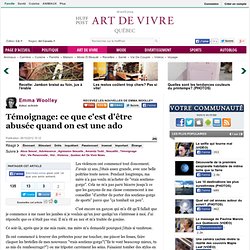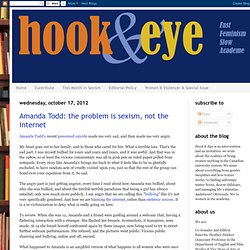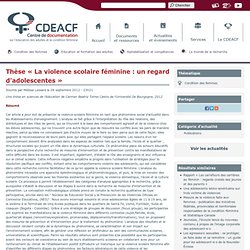

Formation Mots de Passe : La transition primaire-secondaire et la prévention de la violence de genre. Communiqué, publié le 10 octobre 2013.

Canadian Politicians Let Bullied Kids Down. By Jarrah Hodge Despite more and more high-profile bullying cases being reported in the media recently, in the last few days we’ve seen two anti-bullying policies defeated in Canada.

The first was a motion brought forward by the Edmonton Public School District to the Alberta School Boards Association to protect LGBT students and staff from bullying through requiring schools to develop a zero-tolerance policy. Disgracefully, 62% of trustees voted the measure down, including representatives from the Calgary Catholic and public school districts. “Our concern was that if you are appearing to promote one group preferentially over the other, that it’s not appropriate,” Calgary Catholic chairwoman Mary Martin said in the Calgary Herald. ABSA President Jacquie Hansen echoed Martin’s remarks, telling the Edmonton Journal that the ABSA didn’t want a policy that only protected LGBT kids. This might make sense if bullying didn’t thrive on specific social inequalities, stigmas, and stereotypes. Emma Woolley: Témoignage: ce que c'est d'être abusée quand on est une ado. Les violences ont commencé tout doucement.

J'avais 12 ans, j'étais assez grande, avec une belle poitrine toute neuve. Pendant longtemps, ma mère n'a pas voulu m'acheter de "vrais soutiens-gorge". Hook and Eye: Amanda Todd: the problem is sexism, not the internet. Amanda Todd's recent presumed suicide made me very sad, and then made me very angry.

My heart goes out to her family, and to those who cared for her. What a terrible loss. That's the sad part. I was myself bullied for years and years and years, and it was awful. Jarrah Hodge: Calling It "Bullying" Doesn't Do Amanda Todd Justice. Talking about the suicide of 15-year-old Amanda Todd, it's tempting to look for quick answers, to condemn the technology she was using, to believe we can prevent future Amandas from making the same choice by speaking out against "bullying.

" But calling it "bullying" or even "cyberbullying" doesn't do it justice. "Bullying" erases specific social factors and makes it seem like something that you age out of. Adding the "cyber" prefix doesn't necessarily make it more accurate. Technology was a catalyst, but webcams, cellphones, and the Internet aren't the key to understanding what happened to Amanda; systemic sexism is. Thèse « La violence scolaire féminine : un regard d'adolescentes » Soumis par Mélissa Lessard le 28 septembre 2012 - 23h21 Une thèse en sciences de l'éducation de Carmen Beatriz Torres Castro de l'Université De Bourgogne, 2012 Résumé Cet article a pour but de présenter la violence scolaire féminine en tant que phénomène social d'actualité dans les établissements d'enseignement.

L'analyse se fait grâce à l'interprétation du rôle des relations, des stéréotypes et des rôles de genre, qui se trouvent à la base des comportement agressif et de la violence chez les élèves adolescentes, qui ne trouvent une autre façon que de résoudre les conflits avec les pairs de manière réactive, parce qu'elles ne connaissent pas d'autre moyen de le faire ou bien parce que de cette façon, elles gagnent la reconnaissance de leurs pairs avec qui elles partagent l'espace scolaire.
Les raisons d'un tel comportement doivent être analysées dans les espaces de relation tels que la famille, l'école et le quartier ; structures sociales qui jouent un rôle dans la dynamique culturelle. 00732452, version 1] La violence scolaire féminine : un regard d'adolescentes. Missouri Schoolgirl Is Not Alone. Last week we covered the disturbing story of a 12 year-old girl in Missouri who was allegedly forced to write a letter of apology to the classmate she said raped her on school grounds.

When he raped her again (and both his own confession and physical evidence corroborated the new allegation), she was suspended. She’s now suing the school, whose attorneys have called her lawsuit “frivolous.” While this may be an egregious example, it’s far from an isolated case. The victim is described in news reports as “special needs,” and while we don’t know the extent of her disability, it’s worth noting the increased extent to which women and girls with disabilities are subjected to rape and sexual assault. The Justice Department’s first National Study on Crime Against Persons with Disabilities in 2007 [PDF] found that women and girls with disabilities aged 12 and over are twice as likely to be sexually assaulted as women without disabilities, with 47,000 incidents that year alone.